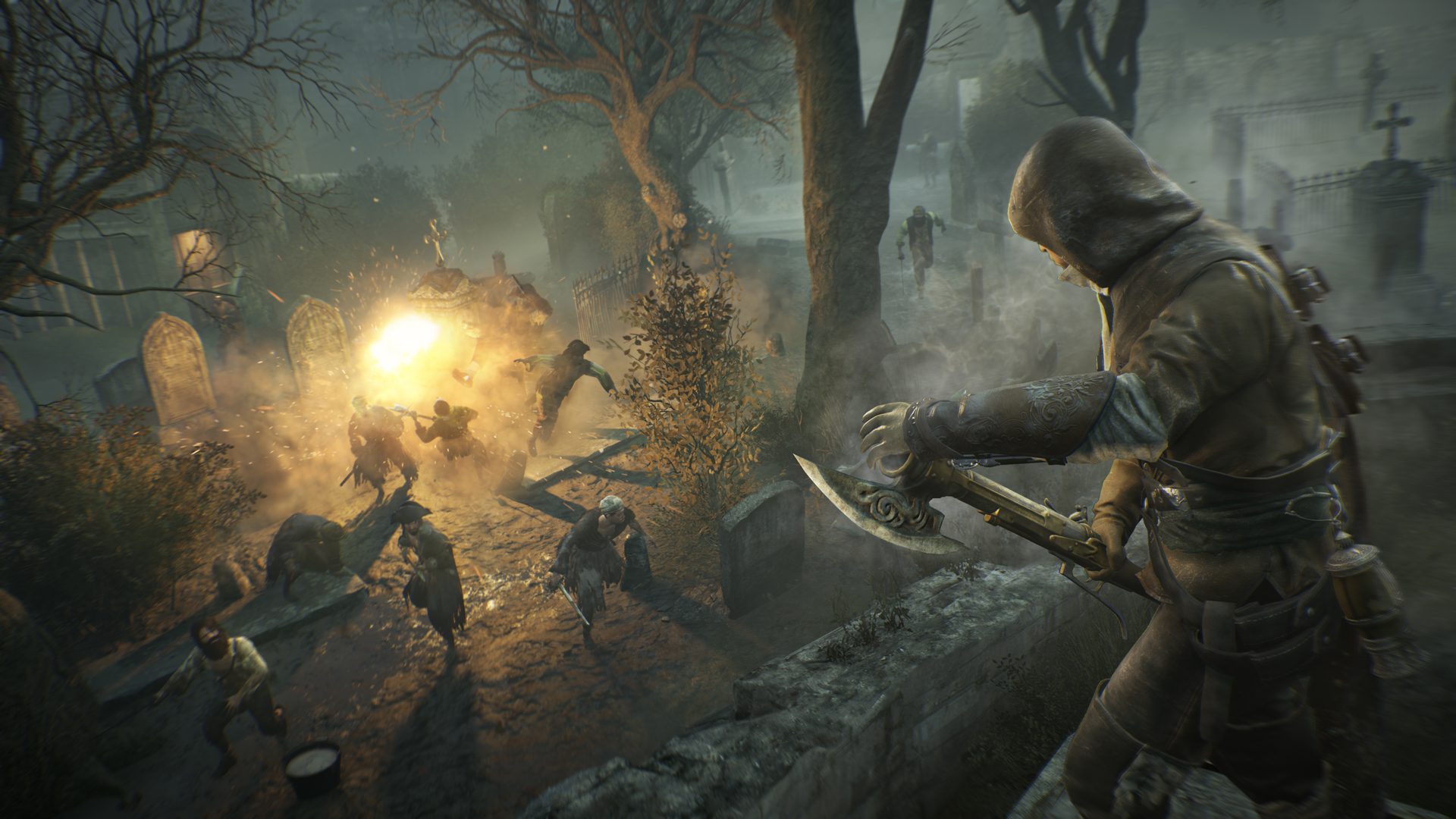[This review contains a big spoiler for the main story of Assassin’s Creed Unity. You’ve been warned.]
In my rambling analysis of Assassin’s Creed Unity, I didn’t mention anything about the game’s myriad performance problems. I didn’t talk about Arno getting stuck in the middle of a hay cart or hovering in mid-air. I didn’t complain about having to restart checkpoints or reset my console. That’s because I played a post-patch version of the game which had had most of those bugs and issues teased out. So I didn’t see any of that stuff. Aside from some rather glaring dips in framerate, and the occasional texture pop-in, Unity ran pretty smooth for me. No crashes, no lost progress – not much fun, admittedly, but for wholly different reasons.
Still, as compensation for shipping a game that was (allegedly, I suppose) thoroughly broken at launch, Ubisoft made a smart decision. They cancelled the game’s Season Pass and made the first planned piece of downloadable content, Dead Kings, free for everyone. I hadn’t even realized it had been released before my Xbox One had downloaded it, installed it, and thrown a little notification onto my screen with that all-too-familiar blip: “Assassin’s Creed Unity: Dead Kings is ready to play”.
Well, if you insist.
I like free stuff. I especially like free stuff which was clearly intended to be a paid release. You’re virtually guaranteed a degree of quality which you generally wouldn’t get in a piece of content without a price attached. That’s very much the case with Dead Kings, which if I didn’t necessarily like enough to reverse my position on the current state of the franchise, I certainly enjoyed to such an extent that I’m glad I took the time to play it. There’s a real sense of mood to Franciade, the provincial town where Parisian Assassin Arno Dorian, still licking his wounds after the closing events of the main story, is attempting to bargain passage overseas. It, like Arno himself, is nursing injuries; after being battered, ruined and tormented by the recent Revolution, Franciade squats in the bloodsoaked muck kicked from the boots of the French capital. This isn’t just a slightly differently-shaped map for Arno to explore – it’s a dense, dour place, rich in character, and it hides as much real estate belowground as it has on the fog-wrapped surface.
Franciade has three major districts to explore, each roughly the same size as an equivalent sector of Paris; there are also, however, three additional subterranean areas, which expand the map considerably with terrain that feels fresher and more interesting than the ruined architecture which Arno – and, by extension, the player – is forced to dutifully clamber over time and time again. And these aren’t the kind of long, dull, maze-like tunnels we saw in Assassin’s Creed III, or even the slightly-improved though still ultimately redundant catacombs of Paris in Unity itself. This is a well thought-out network of caverns, quarries, temples and tombs which extends from one side of the town to another. These tunnels also play host to a new faction of enemies, who behave in a slightly different fashion to the villains you encountered during the main game. Known as Raiders, these guys are essentially brutish grave-robbers who attack in large numbers, but also scatter and flee if you manage to kill their bigger, better-armoured leaders. The underground is designed in such a way that there are typically multiple ways to approach (or avoid) groups of enemies like this, but the dynamic is slightly different when you factor in how essential the Raider’s leader is to their effectiveness. There’s a tremendous amount of satisfaction to be found in clearing out an entire room full of goons just by taking out a single enemy, and watching heaps of them pile over each other to get to the nearest exit is enjoyable every single time you do it. The temptation is still there to just pull out the smoke bombs and go to town, which you can certainly still do, but it doesn’t give quite the same payoff. You’re encouraged both environmentally and mechanically to favour stealth, even though you don’t strictly need to.
Both in terms of the combat and the actual navigation itself, the tunnels of Dead Kings feel more like spaces which require thought – some of it surprisingly lateral. There are puzzles. Nothing too taxing, of course, but certainly problems which are complex enough to have truly earned that distinction. Some of them do require the use of a fiddly lantern item – as do some of the more illogical spacial obstacles – but that isn’t a deal-breaker. At its best, the platforming and exploration in Dead Kings is reminiscent of some of the high points in Ezio’s Renaissance trilogy, which is hardly a bad thing.
Also hiding in the underground is Leon, a young boy who is quickly promoted to the position of primary NPC, despite other familiar faces from Unity popping up now and again for brief, inconsequential cameos. Arno’s relationship with him is a treacherous tightrope walk between saccharine and genuinely sweet, but for the most part it tends towards the latter. Dead Kings is obviously a smaller narrative canvas than Unity’s sprawling, Revolution-spanning shenanigans, and it feels tighter as a result. More personal, too; through the fresh perspective of Leon, rather than the hanger-on’s from the main game, Arno’s story has the focus it needs to establish some proper emotional closure. I wasn’t exactly unsatisfied with how Unity ended, but there was undeniably room for a little more exploration of Arno’s state-of-mind following Elise’s death (especially considering that another death he may or may not have been able to prevent was what spurred him to become an assassin in the first place).
Elsewhere, Dead Kings also introduces a new toy: the Guillotine Gun, which doubles up as a kind of axe-like heavy weapon and also the closest thing to a grenade launcher we’ve seen in the franchise. That sounds pretty antithetical to a stealth game, but somehow it works well, particularly within the more claustrophobic confines of the tunnels. It didn’t quite usurp the glowing sword of doom you get at the end of Unity as my go-to weapon, but I still had a lot of fun messing around with it. (There’s also another weapon you can unlock through Dead Kings by completing a rather involved side-quest, and it’s the most enjoyably useful sword in the entire game. I just wish I could have unlocked it while I still had things left to do).
I don’t know exactly how long I spent with this piece of content – I dicked around a lot, and I made a point of checking out some of the icons on the map I didn’t recognise (Dead Kings introduces Far Cry-style outposts which have you sneak into various areas undetected). There are also new costumes to unlock, extra Nostradamus Enigmas, more Paris Stories and a couple of bonus Murder Mysteries if you’re into that kind of thing. All told, I’d say there are at least 5-6 hours of gameplay here for those looking to explore everything, and the core experience is a much tighter, more focused affair than Unity provided. Is it enough to paper over the colossal cracks left by Unity’s various narrative and mechanical mistakes? Probably not, no. Likewise, it isn’t going to be winning over anyone who is truly sick of this franchise. But for those still enamoured by it, Dead Kings is well worth playing.



